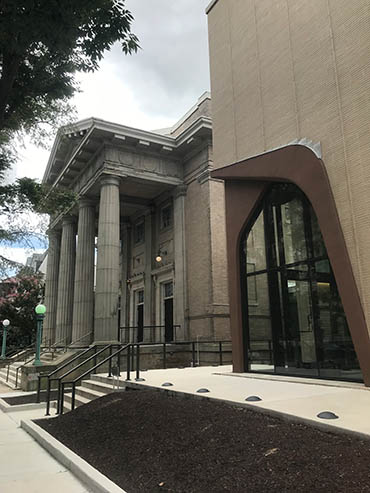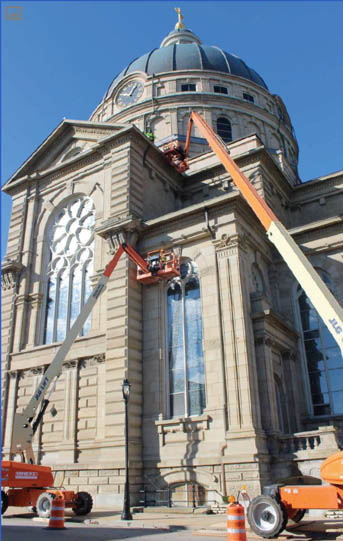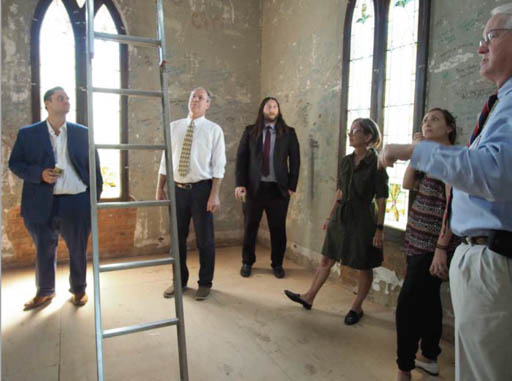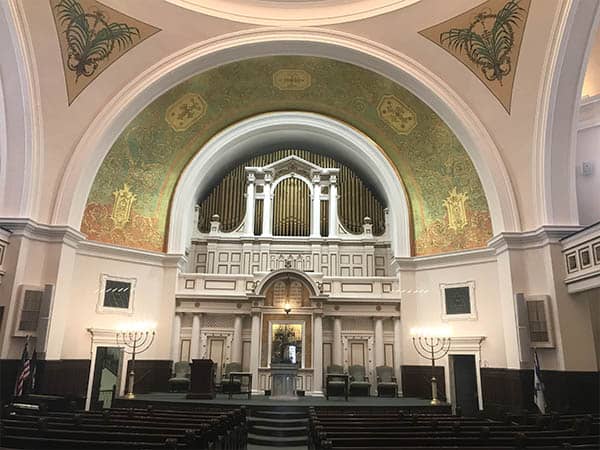We can finally focus on the people!” exclaimed Rabbi Nagel from Congregation Beth Ahabah in Richmond, Virginia. Like several other participants from the first four years of the National Fund for Sacred Places, Congregation Beth Ahabah recently completed a massive multi-year preservation campaign to restore its historic house of worship. In 2017, Congregation Beth Ahabah was facing an intimidating array of capital projects. Its heating and cooling system was on its last legs, most of the building was inaccessible, and leaks from the roof were damaging the decorative plasterwork and painted murals in the sanctuary. With technical assistance and a $250,000 grant from the National Fund for Sacred Places, Congregation Beth Ahabah was able to go above and beyond its original scope of work, completely transforming its campus to become more functional and welcoming. The synagogue buildings are now more energy efficient, completely accessible, and the sanctuary murals are brighter than most members can ever remember. Confidence in the building’s capabilities has inspired Congregation Beth Ahabah to explore new programs, rent its space with more frequency, and provide broader services to the larger community.

Congregation Beth Ahabah Exterior, Richmond VA
Photo: Allison King
The National Fund began in 2016 as a joint effort between Partners for Sacred Places and the National Trust for Historic Preservation to help congregations stay healthy and become more sustainable by investing in their buildings. Faith-based organizations face many unique preservation challenges such as dwindling membership bases, limited opportunities for external funding, and elaborate buildings that can be dauntingly expensive to repair. Preserving historic houses of worship by activating community support, leveraging new funds, and growing congregational capacity are some of the fundamental goals of the National Fund. These aims are achieved by providing congregations with individualized technical assistance so they can successfully raise funds for and complete capital projects, and by making challenge grants that inspire community-wide financial support. Now on its fourth funding cycle, the National Fund has been able to support fifty-four congregations from eighteen different faith traditions in thirty-two states. Participating congregants have raised $9.5 million in new money, thanks in part to the leverage provided by National Fund grants.
Applicants to the National Fund must compellingly convey their historical significance, describe how they plan to preserve their house of worship, and demonstrate that their preservation project will have community value. The program is competitive—only 5% of those who applied in 2019 were invited to participate in the National Fund. Acceptance into the program is just the beginning. Capital grants are only awarded after congregations have construction-ready documents and proof that they have raised the required matching funds. To help congregations achieve their project purpose and reach their financial goals, the National Fund offers an intensive training program which provides resources to assist them in raising funds, navigating the construction process, and engaging with the larger community. Almost half of the fifty-four participants have had their capital grants disbursed; others are still working on fundraising and project preparation. Twelve congregations, including Congregation Beth Ahabah, have finished their projects. Here are a few of the highlights:
- Basilica of St. Josaphat was founded in Milwaukee in 1888. Its third and current building was built by Polish immigrants between 1896 and 1901. In 1929, St. Josaphat was named the third basilica in the United States. After being awarded a grant of $250,000 from the National Fund, St. Josaphat raised funds to make significant repairs to the exterior of their building, including masonry repointing, waterproofing and stained glass window restoration.

Repair work underway at the Basilica of Saint Josaphat, Milwaukee
Photo: Basilica of Saint Josaphat - Christ Church Lutheran is housed in a renowned Mid Century Modern building, the product of a rare father/son collaboration between Eliel and Eero Saarinen, in Minneapolis. The main building designed by the elder Saarinen was completed in 1949. Eliel’s son, Eero, designed the education wing in 1962. The connection between the two buildings was not fully accessible and the building was experiencing water infiltration. Their recently completed project, made possible with help from a $130,000 National Fund award, waterproofed the courtyard and created ADA compliant access.
- First Christian Reformed Church was founded when a small group of members left the Second Reformed Church of Grand Rapids, Michigan in 1857 over doctrinal differences. They founded what is now First Christian Reformed Church, and also had a role in forming the Christian Reformed Church of North America denomination. The congregation’s current building, designed by the notable Grand Rapids firm of J. & G. Daverman, was dedicated in 1912. First CRC used its$100,000 National Fund award to restore the stained glass windows, repoint exterior masonry, and replace the boiler.
- Grace United Methodist Church is an excellent example of late Gothic Revival architecture, unique in the East Dallas neighborhood. It was designed by W. A. Cann, a leading church architect from St. Louis, and incorporates stained glass windows that were created by the Kansas City Stained Glass Studios. In order to maintain its magnificent structure, Grace UMC used its $100,000 National Fund award to seal the building’s envelope and repair damage caused by water infiltration.
- St. Paul’s United Methodist Church descended from one of the earliest Methodist congregations in Cedar Rapids, Iowa, founded in 1840. In 1909, St. Paul’s commissioned architect Louis Sullivan—often called one of the fathers of modern architecture—to design a worship place and Sunday School for the growing Methodist congregation. After Sullivan resigned in 1912 over budget disputes, his design was simplified and completed by W.C. Jones in 1914. St. Paul’s received an award from the National Fund of $250,000 to update its heating and cooling system.
Other finished projects include: Christ Church in Philadelphia, Pa.; Center Church in Hartford, Conn.; The Lutheran Church of the Reformation in Washington, D.C.; North Christian Church in Columbus, Ind.; Shrine of Christ the King in Chicago, Ill.; and Trinity United Methodist Church in Idaho Falls, Idaho.

National Fund team visit to Grace United Methodist Church, Dallas
Photo: Chad Martin
The National Fund
2019 Cohort
Thanks to generous support from Lilly Endowment, Inc., the National Fund is excited to embark on another four-year cycle of funding. Fifty more congregations will be invited to participate beginning in 2020 and continuing through 2024. Partners and the Trust look forward to working in new geographic regions with more faith traditions, growing our collective capacity to save these important historic landmarks. In this spirit, we congratulate the National Fund’s most recent awardees in the 2019–2020 cycle:
- St. Charles Avenue Baptist Church, New Orleans, La.
- Lovely Lane United Methodist Church, Baltimore, Md.
- St. Paul’s Episcopal Church, Syracuse, N.Y.
- Second Presbyterian Church, Chicago, Ill.
- First Congregational Church, Sheridan, Wyo.
- Honpa Hongwanji Hawaii Betsuin, Honolulu, Hawaii
- National City Christian Church, Washington, D.C.
- First Congregational Church of Long Beach, Calif.
- St. Vincent de Paul Parish, Philadelphia, Pa.
- Trinity Episcopal Church, Abbeville, S.C.

